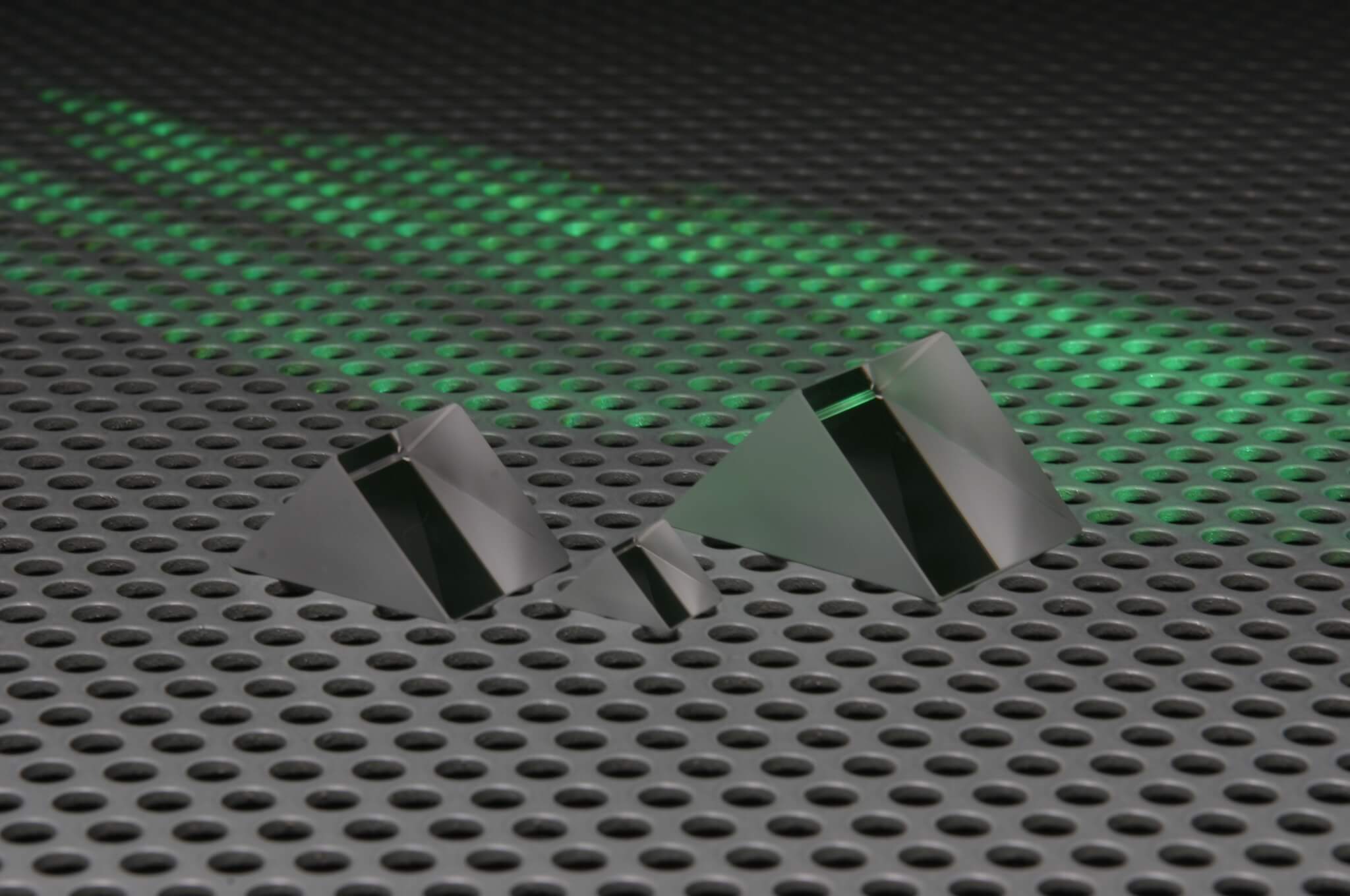Optical prisms are designed and manufactured with the aim of steering, bending, dispersing and shifting light in order to manipulate images.
This is achieved when light enters the prism at a specified angle and in a particular manner depending on factors such as the number and angle of the faces of the prism. They have a minimum of two polished plano surfaces separated by a wedge angle.
How prisms work
The design of each optical prism is key to the way in which light interacts with the prism once entering it. Upon entering the optical prism, the beam of light reflects off one surface or multiple surfaces before exiting the prism – or in some cases is refracted as it travels through the body of the prism.
When light enters a right-angle prism, it hits a single surface inside the prism and is redirected through 90° due to total internal reflection. With other prism specifications, the angle of inclination and thickness of surfaces determines how the light is manipulated.
The key advantage of optical prisms lies in the fact that they can change the direction of a light beam without the need for mirrors or reflectors, and can be manufactured to extremely tight tolerances.
Optical prisms can be custom made to work with specific applications. Options include Right Angle, Penta, Equilateral, Dispersing, Rhomboid and Wedge. They may have to have multiple sides and be polished or finished using complex coatings.
Industries sectors using optical prisms
Optical prisms are used in highly specialised optical instruments and systems which rely on extremely accurate control of light beams.
They can be manufactured to function in high power environments, so are particularly suited to laser systems and for industrial applications such as alignment and tracking. Optical products such as binoculars and telescopes use optical prisms in place of multiple mirrors, as do scientific instruments such as microscopes, range finders and atmospheric monitoring equipment.
Material considerations optical prisms
Materials used in optical prisms must be selected according to:
- Thermal Expansion Coefficient – the degree to which the surrounding temperature can impact the performance of prism. This is particularly important if the prism is to be used as part of a system used in external environments subject to frequent or large shifts in temperature.
- Density – the material density of an optical prism will impact on the operational weight of a system in which multiple prisms are present, and is potentially a vital factor in more exact and precise scientific instrument applications.
- Hardness – the main impact of the prism material’s hardness is the complexity of the fabrication process, which is typically reflected in the cost of the finished system and the operational longevity of the prism.
Materials used in optical prism manufacturing
The materials used in the manufacture of optical prisms are selected on the basis of their optical qualities which determine the prism’s performance. These qualities determine factors such as the speed at which light passes through the material and the degree of refraction or dispersal.
The most popular materials used in the manufacture of optical prisms include the following:
Optical prism surface coatings
Optical prism performance can also be also controlled by the application of optical coatings. Coating options include the following:
- Mirror Coating
Various different metals or dielectrics can be applied to the surface of the prism when something more than natural internal reflection is required.
- Broadband Antireflective (BBAR)
A multi-layered coating which minimises the amount of light lost through reflection when passing through the prism.
- Wide angle broadband AR coating
This coating is the ideal solution when the angle of incidence of light passing through the prism is extended and the antireflective properties are needed.
- Polarising coating – this coating allows light of a specific polarization to pass through, controlling the angle of incidence and the wavelength.
- Single layer Magnesium Fluoride (MgF2) – a coating used in a wide range of standard commercial applications to reduce the incidence of light lost through excess reflection when passing through the prism.
- Edge black painted – a coating applied to the outer surface of a prism to prevent stray light impacting on performance and to protect the internal mirror coated surface.
Popular Optical Prisms from UQG Optics
Among the types of prism which can be supplied from stock or custom manufactured by UQG Optics are the following:
- Penta prisms: deviate light passing through by 90° without inverting or reverting the image.
- Equilateral prisms: split white light into the component colours along the spectrum. The same can be achieved by a dispersing prism.
- Rhomboid prisms: shift the beam of light without changing the angle or inverting the image.
- Right-angle prisms: right angle prisms from UQG Optics shift light passing through them by 90°. Under standard conditions the images produce by the right-angle prism is inverted or reverted left-handed depending upon the orientation of the prism. Reflective aluminium coatings can be applied to the interior hypotenuse face of the right-angle prism in combination with edge black painting, to deviate the path of the beam of light by 180°.
Right-angle prisms can be supplied in a range of custom sizes and lengths and with AR coating as needed. Materials include BK7, UV Fused Silica, Quartz, optical glasses, Calcium Fluoride (CaF2), Germanium (Ge) and Silicon (Si).
Next Steps
To find out more about Optical Prisms from UQG Optics, or any of our other optical products contact us on 01223 420329 or email our sales team at info@uqgoptics.com




